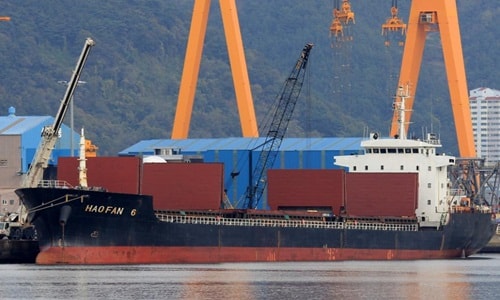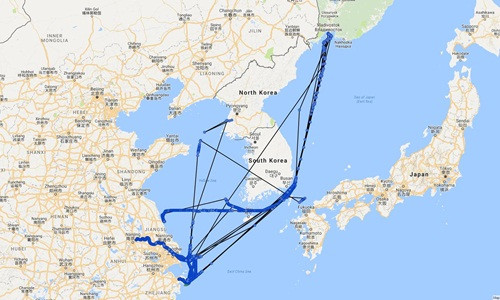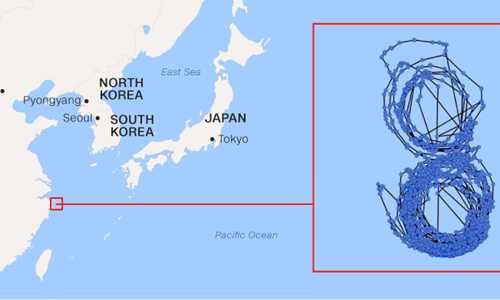Journey of the North Korean cargo ship sanctioned by the United Nations
The Hao Fan 6 ship, which was carrying banned goods for North Korea, was banned by the United Nations from calling at any port in the world and had to circle around at sea for many days.
 |
Hao Fan 6 ship was sanctioned by the United Nations. Photo: CNN. |
On October 10, the United Nations Security Council imposed a ban on four vessels, including the 140-meter Hao Fan 6, from entering any port worldwide. These ships are accused of transporting coal, seafood and iron ore to North Korea, in violation of sanctions imposed on Pyongyang over its nuclear and missile programs.
At the time the ban was announced, the Hao Fan 6 was in waters south of South Korea, according to ship tracking information from MarineTraffic. Its transponder remained active until 11:17 p.m. on October 10. After that, the Hao Fan 6 disappeared from the monitoring system, according to CNN.
The Hao Fan 6’s route in the weeks before the UN ban was imposed shows the massive 8,343-ton cargo ship apparently sailed overland, across a large swath of South Korea. Of course, this wasn’t due to a mechanical problem. The Hao Fan 6 likely turned off its transponder.
Most modern ships can be tracked using a transponder called an Automatic Identification System (AIS). The International Maritime Organization (IMO) requires large ships to have AIS. Ships can hide their whereabouts by turning it off. Once it is turned back on, the tracking data will show a significant change in the ship's position, moving much farther away from the last time AIS was active.
 |
The Hao Fan 6's journey over the past two years shows that it has only operated in waters near North Korea, South Korea, China, and Russia. Photo: CNN. |
“There’s nothing you can do to stop captains from turning them on and off,” said Andrea Berger, a scholar who studies North Korea sanctions and its weapons programs at the Middlebury Institute of International Studies in the US.
After disappearing on October 10, the Hao Fan 6 did not turn on its transponder for the rest of the month. According to Berger, ships involved in illicit activities related to North Korea often turn their transponders on and off multiple times during their journeys. Experts say transponders are typically only turned off if a ship is under threat, such as from piracy.
Three trains to North Korea
Hao Fan 6's historical data shows the ship visited North Korea three times last year, sailing on traditional coal shipping routes. In the fall of 2016, it was spotted near the North Korean port city of Nampo twice. The first time was on September 27 and the second time was on October 17.
This time, it was near Lanshan, a port and coal depot in Rizhao City, Shandong Province, China. Tracking data later showed it returning to Nampo. On October 20, it appeared off the North Korean coast again and then turned off its locating signal repeatedly for several days.
If the Hao Fan 6 transported coal on the above journeys, it would have violated the UN Security Council sanctions resolution passed in March 2016.
Hugh Griffiths, coordinator of the UN Panel of Experts on North Korea, which monitors the implementation and effectiveness of sanctions against North Korea, did not comment on the Hao Fan 6's suspected coal shipment. However, he stressed that all members must fully implement UN Security Council sanctions resolutions. "Part of that is to closely monitor ships carrying coal," Griffiths said.
Coal is a vital economic lifeline for Pyongyang. In 2015, coal exports earned North Korea nearly $1 billion, according to United Nations data. Chinese companies are big buyers because North Korean coal is cheap and close to China.
During a US Senate hearing in September, Marshall Billingslea, the US Treasury Department's assistant secretary for counterterrorism financing, used satellite imagery and AIS data to prove that three ships illegally transporting North Korean coal turned off their AIS transponders during their journeys between China and Russia.
Recently, US Ambassador to the United Nations Nikki Haley called on the international community to step up action to prevent violations of sanctions against North Korea.
"The UN Security Council has banned coal exports from North Korea, but we continue to hear reports that Pyongyang continues to smuggle coal to its Asian neighbors using deceptive tactics to disguise the origin of the coal," Haley told the UN Security Council shortly after North Korea tested a missile in November.
Two offices in Hong Kong
On paper, the Hao Fan 6 is owned by a Hong Kong-based company called Trendy Sunshine, which is located on the 10th floor of the Billion Centre, according to Equasis, an online database of maritime information created by the European Union (EU) and the French Maritime Administration (FMA).
When visiting the Trendy Sunshine office, the reporter could not find it, instead it was the headquarters of SBC International, the company that serves as the secretary office for Trendy Sunshine.
In Hong Kong, companies can share the same address with their company secretary. Companies are required by law to have both a director’s office and a company secretary. Companies outside Hong Kong that do business in the territory often share this address to save on office rental costs.
But this is also a trick for companies to avoid sanctions. An investigation byCNNA study conducted in October found that many companies accused of helping North Korea evade sanctions had set up front companies in Hong Kong to take advantage of relatively lax oversight there.
Firms like SBC International provide merger services to foreign companies. They sometimes work for thousands of clients at a time. SBC International’s website says it provides about 400 services to more than 400,000 clients. The company has offices in Hong Kong, Singapore, and several Chinese cities, including Shanghai, Hangzhou, Beijing, Shenzhen, Guangzhou, and Nanjing.
Shen Zhong International Shipping, the company that directly operates the Hao Fan 6, also shares the same address with four other offices of SBC International in Hong Kong. The company does not own the Hao Fan 6, but manages the day-to-day operations of the Hao Fan 6 and is responsible for hiring the captain and crew for the ship.
SBC International's sharing of an address with Trendy Sunshine and Shen Zhong International Shipping is not illegal, but it is also unusual.
Trendy Sunshine has a sole shareholder, Yue Diangang. According to Hong Kong corporate records, Mr. Diangang resides in Rongcheng City, Shandong Province, China.
Jessica Knight, director of Washington-based business relationship analysis firm Sayari Analytics, said his staff found only one person in Shandong province with that name, and that was a cement entrepreneur.
According to Knight, the fact that this person is a cement businessman, and not a logistics or maritime businessman who owns a shipping vessel, is puzzling.
Trendy Sunshine acquired the Hao Fan 6 from Zhejiang Haofan Shipping on February 24, 2017, according to Equasis data.
On the same day, Zhejiang Haofan Shipping transferred the Hao Fan 2 to Advance Superstar in Hong Kong. Like Trendy Sunshine, Advance Superstar shares an address with a branch of SBC International. According to Equasis data, Zhejiang Haofan Shipping now owns only one ship: Hao Fan 3.
Like Hao Fan 6, AIS data from Hao Fan 3 shows its journey jumping widely between South Korea and Japan, a sign that the ship's AIS transponder was turned off.
Although the Hao Fan 2 and Hao Fan 3 were not found to be doing anything illegal and were not sanctioned by the United Nations, both vessels turned off their AIS transponders and operated in the same area as the Hao Fan 6. Knight said the anomalies were enough for the United Nations to take measures to monitor them.
Running around for over two weeks
 |
The Hao Fan 6 has been circling the East China Sea near China for the past two weeks. Photo: CNN. |
More than a month after turning off its location signal on October 10, the Hao Fan 6's AIS device was turned back on at a time when it was in the East China Sea, hundreds of kilometers away from the position obtained from the nearest AIS data.
The Hao Fan 6 then circled the same area for more than two weeks, which George Lopez, a former member of the UN Panel of Experts on North Korea, said could have been a way for the Hao Fan 6 to mislead UN investigators. Lopez said he had never seen such a strange circling behavior from the ship before.
If the Hao Fan 6 requests to call at a port, authorities can see its logbook and cargo manifest. Incomplete voyage data will get it into trouble with customs. With nowhere to go and no port to accept it, the Hao Fan 6 is stuck wandering around the sea.
According to VNE
